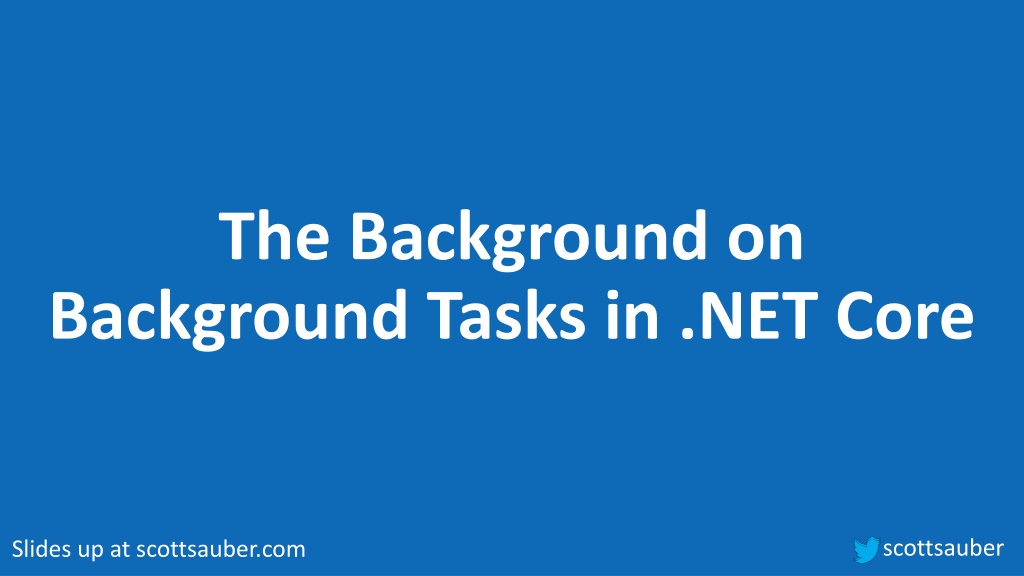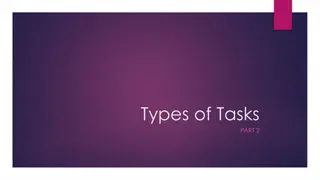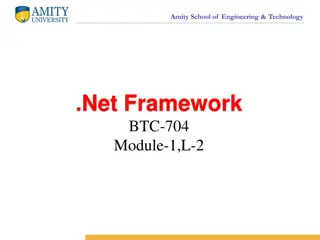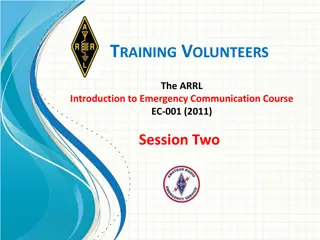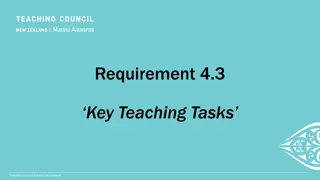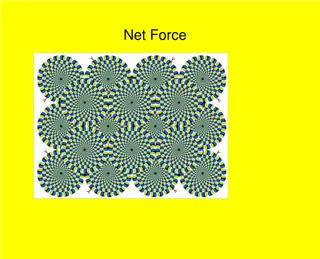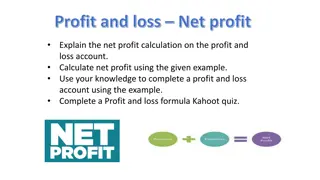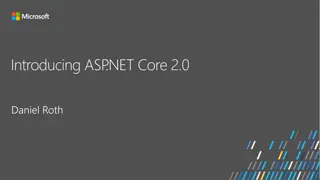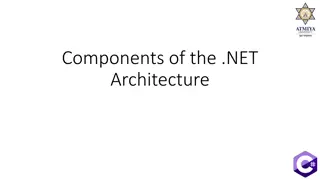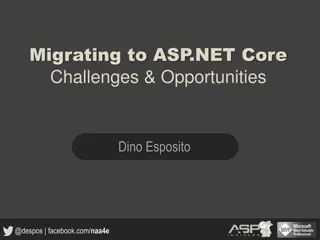Understanding Background Tasks in .NET Core
Explore the world of background tasks in .NET Core with this informative slideshow by scottsauber. Learn about various types of background tasks, suitable problems, available options like IHostedService, BackgroundService, Worker Service, Hangfire, and more. Discover how to choose the right option for your needs and get insights into running background tasks efficiently. Whether you're a .NET Core developer or looking to delve into running background tasks, this slideshow has got you covered!
Uploaded on Sep 23, 2024 | 0 Views
Download Presentation

Please find below an Image/Link to download the presentation.
The content on the website is provided AS IS for your information and personal use only. It may not be sold, licensed, or shared on other websites without obtaining consent from the author. Download presentation by click this link. If you encounter any issues during the download, it is possible that the publisher has removed the file from their server.
E N D
Presentation Transcript
The Background on Background Tasks in .NET Core scottsauber Slides up at scottsauber.com
Audience .NET Core Developers In need of running a background task scottsauber
Agenda What are background tasks/jobs? What type of problems are suitable for a background task/job? What options are out there? IHostedService BackgroundService Worker Service Hangfire Why would I choose one over the other? Deep dive into each Demos Questions scottsauber
Goal Know all your options for running background tasks Why choose one over another scottsauber
Who am I? Software Consultant at Lean TECHniques Co-organizer of Iowa .NET User Group Friend of Redgate Blog at scottsauber.com scottsauber
What problem do background tasks solve? Cron jobs Process messages from a queue every X minutes Clean up database or file system every X minutes Send email notification every X minutes under certain circumstances Refresh cache every X minutes Check for updates to database every X minutes and push updates via SignalR Perform some CPU intensive work asynchronously Re-train ML datasets scottsauber
Options IHostedService BackgroundService WorkerService Hangfire Cloud options scottsauber
These options are kind of like baking cookies
IHostedService Make Your Own Recipe (Cookie Jar Included)
What is an IHostedService? Lets you host a background job inside an ASP.NET Core App ASP.NET Core app is your cookie jar Interface with StartAsync and StopAsync Raw, fundamental building block for other options Register via dependency injection and services.AddHostedService<T> scottsauber
How does an IHostedService work? Register with DI StopAsync s cancellation token has 5 seconds to shutdown gracefully StopAsync might not be called if the app shuts down unexpectedly scottsauber
How does an IHostedService work? scottsauber Image Credit: Andrew Lock
How does an IHostedService work? StartAsync blocks the rest of your app from starting Push blocking long-running work out of StartAsync This goes for BackgroundService later UNLESS, you truly don t want your app to boot until this finishes i.e. Database Migrations scottsauber
When do I use IHostedService? You will implicitly use it with BackgroundService and Worker Services You need full control over Starting and Stopping AND will not use the base BackgroundService implementation scottsauber
When do I NOT use IHostedService? Should be using BackgroundService or WorkerService 95%+ of the time Other reasons will be the same as BackgroundService (next) scottsauber
BackgroundService Follow The Recipe (Cookie Jar Included)
What is a BackgroundService? Lets you host a background job inside an ASP.NET Core App ASP.NET Core app is your cookie jar Abstract class, implements IHostedService Exposes ExecuteAsync abstract method Handles Starting and Stopping scottsauber
How does a BackgroundService work? Register with DI Exposes ExecuteAsync abstract method Can still override StartAsync and StopAsync scottsauber
When do I use BackgroundService? Need a simple background task runner Either as part of your ASP.NET Core application or by itself Less gotchas than IHostedService Can t accidentally prevent app from booting unless override StartAsync Handles cancellations Want an ASP.NET Core endpoint to health check your background task Instead of WorkerServices scottsauber
When do I NOT use BackgroundService? Too much co-location with your app/API can get unruly and outweigh the convenience of co-location It Depends Scaling out can be a problem if your code isn t idempotent Fix by making code idempotent or not allowing scale out scottsauber
WorkerService Follow The Recipe (BYO Cookie Jar)
What is a WorkerService? Enhanced .NET Core Console App template dotnet new worker o my-custom-worker Allows you to have an IHost Configuration, Dependency Injection, Logging, etc. Registers a Worker class as a HostedService Does not take an opinion on how to host console app No cookie jar Console app called from scheduler Windows Service systemd scottsauber
How does a WorkerService work? Project Sdk of Microsoft.NET.Sdk.Worker PackageReference to Microsoft.Extensions.Hosting scottsauber
How do I host WorkerServices? Scheduler calls Console App Windows Scheduled Tasks, k8s cron jobs, Azure Logic Apps, AWS Scheduled Tasks, GCP Cloud Scheduler Windows Service or Systemd (Windows or Linux) scottsauber
When do I use WorkerServices? Want an out-of-proc way of running background tasks Prefer hosting background services outside of a web app Avoid app pool recycles Natural migration for a full .NET framework Windows Service scottsauber
When do I NOT use WorkerServices? Prefer deploying as a web app Want to co-locate with existing web app/API Want a healthcheck endpoint scottsauber
Hangfire Buy pre-packaged cookies
What is Hangfire? Full featured library for running jobs in ASP.NET Core Free for commercial use but paid if you want support ($500-$4500/yr) Comes with UI for monitoring and history Supports Cron and ad-hoc running of jobs Allows for continuations Automatic retries Supports concurrency limiting Persists job state to database scottsauber
How does Hangfire work? Serializes method call and all arguments Creates background job based on that information Saves job to persistent storage Starts background job if immediate scottsauber
When do I use Hangfire? Want to host jobs in ASP.NET Core Need features Hangfire offers Don t want to write plumbing code Ok with relying on a 3rd party library scottsauber
When do I NOT use Hangfire? Do not want to host jobs in ASP.NET Core Have basic needs and do not need Hangfire s features Do not want to rely on 3rd party library More control over what happens scottsauber
Cloud options Azure Functions Azure WebJobs AWS Lambdas GCP Cloud Scheduler + Cloud Functions Didn t cover these to avoid cloud specific scottsauber
Takeaways Awareness to all the options available to you More information to make the best decision for you and your company scottsauber
Resources https://docs.microsoft.com/en- us/dotnet/architecture/microservices/multi-container-microservice- net-applications/background-tasks-with-ihostedservice https://www.hangfire.io/ https://app.pluralsight.com/library/courses/building-aspnet-core- hosted-services-net-core-worker-services/ This slide deck scottsauber
Questions? scottsauber Slides up at scottsauber.com
Thanks! scottsauber Slides up at scottsauber.com
